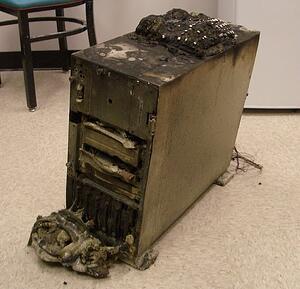 If you deal with servers and IT matters on a daily basis, you probably know the importance of creating a cool, comfortable environment for those valuable pieces of hardware. Sure, most systems employ cooling fans to tackle the heat, but in many cases, fans alone may not prevent a server meltdown from happening. The folks over at Fans of Cool Fans wrote a great piece about server overheating and the steps that can be taken to avert a data center disaster.
If you deal with servers and IT matters on a daily basis, you probably know the importance of creating a cool, comfortable environment for those valuable pieces of hardware. Sure, most systems employ cooling fans to tackle the heat, but in many cases, fans alone may not prevent a server meltdown from happening. The folks over at Fans of Cool Fans wrote a great piece about server overheating and the steps that can be taken to avert a data center disaster. What Happens When A Server Overheats?
Server nodes produce heat. A LOT of heat. That’s why servers are outfitted with CPU cooling fans, and data center managers get creative with high-tech ventilation systems to shuck heat away from the server.
When the nodes around the CPU reach temperatures around 85-90°F and remain at that temperature for several minutes, you run the risk of potentially blowing the CPU. Meltdown. In many cases, nothing is salvageable in this situation, and you’re out a very important piece of equipment that may serve critical business operations.
In a situation such as this, even if the CPU is replaced and your server is once again functional after the overheating incident, you may still run into problems down the road due to the meltdown. Since critical components such as the memory, motherboard and power supply were exposed to the extreme heat, they are much more prone to fail sooner rather than later.
7 Tips To Prevent Server Overheating
Replacing fried CPUs and motherboards is not fun. Replacing entire servers is even less so. That’s why preventing server overheating before it occurs is incredibly important. Here are a few tips to help keep things cool in the server room:- Survey the room. Where are the vents located? What's the airflow like? Plan your setup and cooling fan locations to achieve the best airflow possible.
- Eliminate clutter in the room to optimize airflow and circulation. This also makes the room safer and easier to work in when you need to reach those hard-to-get-to areas.
- Try to keep the temperature in the room below 77°F. The cooler, the better.
- If there are empty spaces on your server rack, install blanking panels to fill them. A rack with empty spaces will reduce airflow.
- Consider utilizing a rack enclosure that has a built-in cooling system.
- Employ a solution to monitor the temperature in the server room. Some temperature monitors will even email you when the room gets too hot.
- Use a redundant power supply designed for your specific equipment.
When you’re an IT professional, there’s nothing more painful that losing critical information, experiencing downtime, and having to replace equipment that’s vital to your company. By instituting smart, calculated cooling tactics, you may be able to sidestep these data center dangers.
If you have any questions releating to server overheating, or have any other general server questions, feel free to contact us at 1-855-4SRVERS, or visit our website at www.servermonkey.com.











